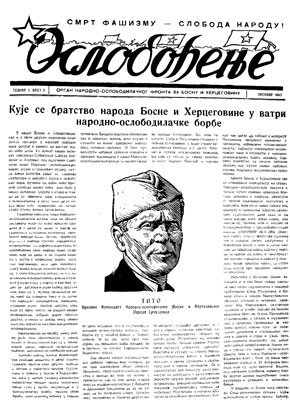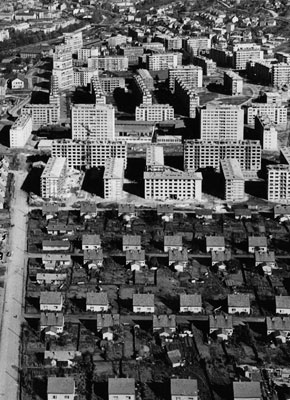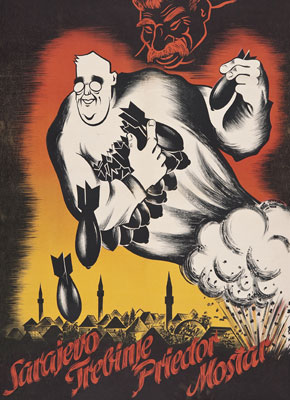The period of the Independent State of Croatia / People's Liberation war in Yugoslavia
The Time of Change
Slavko Kvaternik's proclamation of the Independent State of Croatia was broadcasted on Radio Zagreb on 10 April 1941. On the same day, the proclamation was published in a special edition of the Croatian People (Hrvatski Narod) newspaper. This marked the fulfilment of the centuries-old dream of Croatian people - to have its own, independent state. However, the circumstances of its establishment, such as its dependency on the military might of the Axis Powers - Germany and Italy, its general national policy, particularly its racial policy towards Jews and Serbs, contributed to the negative historic reception of this state. The Jasenovac concentration camp has become a synonym for mass killings and atrocities, primarily of the Serbs, Jews as well as the Roma, Bosnians and others - including those Croats who did not support the Ustashe movement. One should mention also the case of Bleiburg in Austria, as the site of mass execution of the Croats loyal to this state, which was the event that marked the end of the war in Yugoslavia. More than any other place or event, Jasenovac and Bleiburg, as two sites of mass executions, defined the period of the Independent State of Croatia.
On the other hand, after the capitulation of the Kingdom of Yugoslavia, the Communist Party of Yugoslavia organised the People's Liberation War (NOR). Thus, in Belgrade, on 4 July 1941, the Communist party of Yugoslavia decided to start massive popular rebellion. This rebellion marked the beginning of the struggle for the liberation of Yugoslavia with the participation of all the peoples of the then state. In Serbia, the rebellion was announced on 7 July and in Croatia and Bosnia and Herzegovina on 27 July 1941. From the beginning, the Peoples' Liberation Movement, aimed at bringing together all the peoples of Yugoslavia into the united front in the struggle against occupying forces, was based on the principles of equality, brotherhood and unity. To this end, prevailingly multi-ethnic partisan units were formed. At the same time, leaders of the resistance movement worked actively on a political and administrative organisation in liberated territories.
Key decisions and fundamental legal acts and decisions were taken at the sessions of the Anti-fascist Council of the Peoples' Liberation of Yugoslavia (AVNOJ), out of which the first one was held in Bihać on 26-27 November 1942, and the second one in Jajce on 29 November 1943. These sessions were actually national assemblies organised for the reinstatement of Yugoslavia.
This new Yugoslavia was born as a state made of several federal units. Special attention was paid to the solution of the national question. With this very aim, the National Anti-fascist Council of the Peoples' Liberation of Bosnia and Herzegovina (ZAVNOBiH) was formed in Mrkonjić-Grad on 25 November 1943; it reaffirmed the statehood of Bosnia and Herzegovina and equality of all of its peoples and ethnic minorities. There is no doubt that out of all the Yugoslav countries, Bosnia and Herzegovina suffered the greatest losses in the Second World War and that it paid the highest human and material price for the cause of renewal of Yugoslavia. All great and decisive battles of the Second World War in Yugoslavia were fought in its territory, such as the battles of Kozara, Neretva, and Sutjeska.
The majority of Bosnian and Herzegovinian intellectuals, public figures, writers and artists opted for the people's liberation movement, particularly those gathered around the Collegium Artisticum club. The newspaper published by the People's Liberation Movement Oslobođenje was launched in 1943. Vojo Dimitrijević, Skender Kulenović and numerous others were involved in its publication. In 1942, Skender Kulenović wrote his famous poem "Stojanka majka Knežopoljka".
In should also be mentioned that, for the members of the Communist Party of Yugoslavia, this period of struggle for liberation of Yugoslavia was at the same time the period of socialist revolution - this had a special impact on the development of political, social, economic and cultural life in Yugoslavia and in Bosnia and Herzegovina after the liberation in 1945.
A poster without text, but with a clear visual message explaining the centuries-old quest of Croatian people to have its own independent state. Slavko Kvaternik's proclamation of the Independent State of Croatia was broadcasted on Radio Zagreb on 10 April 1941. On the same day, the proclamation was published in a special edition of the Croatian People (Hrvatski Narod) newspaper.
The majority of Bosnian and Herzegovinian intellectuals, public figures, writers and artists opted for the people's liberation movement, particularly those gathered around the Collegium Artisticum club. The newspaper published by the People's Liberation Movement Oslobođenje was launched in 1943. Vojo Dimitrijević, Skender Kulenović and numerous others were involved in its publication.
This design - the picture of a leader (Ante Pavelić) surrounded by an enthusiastic crowd - is very interesting as a symbolic design model. In the years after 1945, in the Socialist Yugoslavia, it would become the model for depicting the leader, Josip Broz Tito, and would, thus, become a synonym of the "personality cult".
Josip Broz Tito (Kumrovec 1892 - Ljubljana 1980) The Communist Party of Yugoslavia, led by Tito, was the organiser of resistance and Peoples' Liberation Movement in Yugoslavia against the Axis Powers in 1941-1945, but led the renewal of the state and socialist social development in Yugoslavia after 1945. Tito was its first and lifelong President.
In line with usual Fascist practice, the new government insisted that all media outlets and literature were at its service, and soon took a full control over publishing, media and theatres. The official Government publication was Narodne novine (People's Gazette). Among daily newspapers, the most important was Hrvatski narod (Croatian People), issued in Zagreb, Hrvatski list (Croatian Newspaper) issued in Osijek, and Novi list (New Newspaper) issued in Sarajevo.






